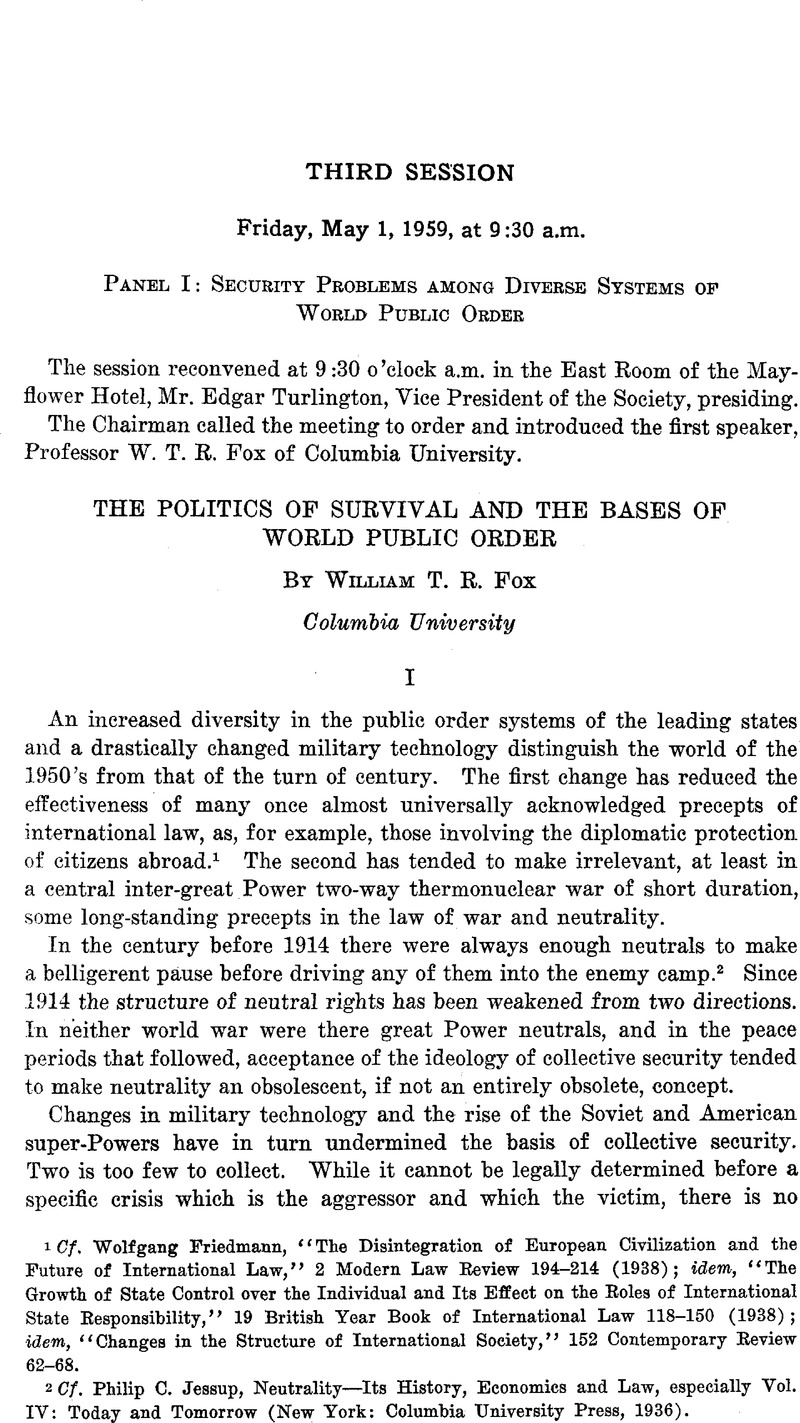No CrossRef data available.
Published online by Cambridge University Press: 27 February 2017

1 Cf. Wolfgang Friedmann, “The Disintegration of European Civilization and the Future of International Law,” 2 Modern Law Eeview 194–214 (1938); idem, “The Growth of State Control over the Individual and Its Effect on the Roles of International State Responsibility,” 19 British Year Book of International Law 118–150 (1938); idem, “Changes in the Structure of International Society,” 152 Contemporary Review 62–68.
2 Cf. Philip C. Jessup, Neutrality—Its History, Economics and Law, especially Vol. IV: Today and Tomorrow (New York: Columbia University Press, 1936).
3 The phrase “corporal dissolution” is taken from Myres S. McDougal and Florentino P. Felieiano's “International Coercion and World Public Order: The General Principles of the Law of War,” 67 Yale Law Journal 797 (1958).
4 Myres S. McDougal and Harold D. Lasswell, “The Identification and Appraisal of Diverse Systems of Public Order,” 53 A.J.I.L. 11 (1959).
5 Professor John Herz has described this process in terms of what he calls the security dilemma in two books, International Politics in the Atomic Age (New York: Columbia University Press, 1959), and Political Eealism and Political Idealism, A Study in Theories and Realities (Chicago: University of Chicago Press, 1951).
6 See Marion William Boggs, Attempts to Define and Limit “Aggressive” Armament in Diplomacy and Strategy (Columbia: University of Missouri, 1941).
7 Cf. Arthur Lee Burns, “From Balance to Deterrence,” 10 World Politics 512–536 (1958); and Bernard Brodie, “The Anatomy of Deterrence,” 11 ibid. 173–191 (1959); see also Albert Wohlstetter, “The Delicate Balance of Terror,” 37 Foreign Affairs 211–235 (1959), for a reminder that maintaining a second-strike capability is neither easy nor inexpensive.
8 Anthropological or metaphysical realism is the term used by Professor Herz, International Politics in the Atomic Age, p. 232, to describe what I had called “doctrinaire realism” in “Les fondements moraux et juridiques de la politique étrangère amfiricaine,” La politique étrangère et ses fondements (par 1'Association Française de Science Politique), pp. 278–290 (Paris, 1954).
9 1941 Proceedings, American Society of International Law 97. Cf. H. W. Briggs, “The Attorney-General Invokes Eebus Sic Stantibus,” 36 A.J.I.L. 89–93 (1942), who argued that the Attorney General's invocation in August, 1941, of the principle of rebus sio stantibus was “reckless and unnecessary” even on the assumption that unilateral United States suspension of the Loadline Convention did in fact help Britain at a critical moment.
10 Frederick S. Dunn, “International Law and Private Property Rights,” 28 Columbia Law Review 167–180, especially pp. 170 ff. (1928).
11 Seymour Melman, Inspection for Disarmament (New York: Columbia University Press, 1958).
12 McDougal and feliciano, loc. cit. 817.